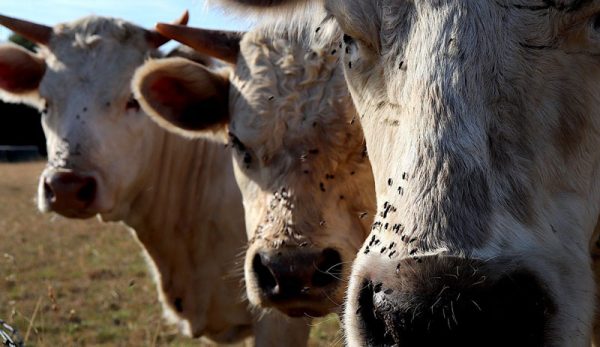
Hot weather is here, and so are the insects. No matter the size of your farm or the livestock you raise, when the weather gets warmer, flies become a bother. Let’s talk a little about fly control—why you should care about controlling these six-legged pests and how to do it.
Different Kind of Flies
Most people are more than familiar with the common house fly. But you might be surprised to know that many other fly species exist. What flies you see, in fact, can depend on the particular livestock you raise.
Cattle Flies
Fly control is necessary for reasons that depend on the insect species. Horn flies and face flies are some of the most common flies that affect cattle.
- The horn fly has a painful bite, and infestations can result in weight loss because they cause excessive agitation and stress.
- Face flies don’t bite but instead feed on eye excretions. It’s little wonder, then, that this particular insect spreads a bacterial disease in cattle called infectious bovine keratoconjunctivitis, more commonly known as pink eye.
Sheep Flies
Fly control applies to sheep, too. One particularly nasty ovine condition is called fly strike. This occurs when flies lay their eggs in damp wool.
As the eggs hatch, their larvae (also known as maggots) begin to infest the animal’s skin. Understandably this can spread infection and cause significant harm to the sheep.
Horse Flies
Horses get their own fly named after them: the horse fly. These large, feisty fellows pack a wallop of a bite and don’t just have a taste for horses. Humans, cattle, dogs—almost any mammal will do.
Other types of flies pester horses as well. They can cause watery eyes and skin hypersensitivity that may manifest in welts, itchiness, and hair loss.
Read more: Fly strike isn’t fun to think about, but it’s important to protect your chickens from the condition.
Fly Control
Loss of livestock production, animal welfare and disease control—now that we know the major reasons why flies of all types are no good for the barn, how do we go about controlling them? This is the tricky part.
The most important thing to understand about proper fly control is that you need a multimodal approach. Unfortunately, there isn’t one action that will continuously eliminate flies all season.
But fortunately, this gives you some options with which to tailor fly control to best fit your own operation.
Environmental Control
Many fly species feed on and lay eggs in manure and other waste. So keep your manure/composting area as far away from your animals as possible. If you keep animals in barns at any point during the summer, make sure their stalls and paddocks stay clean and dry.
Keep trash and human food picked up and placed in tightly sealed containers. Commercial animal feeds with molasses and other sweeteners are also very attractive to pests of all kinds.
Additionally, for animals spending time in the barn, air circulation is key to fly control. Stagnant air is a prime landing and feeding environment for flies. When possible, have aisle doors and windows wide open to facilitate a natural cross breeze.
For the dog days of summer when no breeze is available, invest in some heavy-duty fans. Your animals will thank you.
Fly Tape & Traps
Fly tape is an old-school remedy also known as flypaper or fly ribbon. Who hasn’t walked into a barn and seen dozens of sticky strips hanging from the ceiling covered in flies?
Although these do work for fly control, their success is directly proportional to how often they are replaced. A full fly tape is an ineffective fly tape.
Fly traps are another method and less conspicuous. These contraptions lure flies in and don’t let them back out. Fly predators are another nifty invention; tiny parasitic wasps (a kind that doesn’t sting humans) can be released in a barn periodically to decrease the resident fly population.
Read more: Follow these tips to protect your cattle against pinkeye.
Chemicals
There is also a chemical arsenal to help fight flies. The kind you choose can depend greatly on the types of animals you raise. Ear tags containing fly repellent can be very effective in cattle, while horse owners are very familiar with fly sprays, fly sheets and fly masks.
Fly rubs can also work for livestock other than horses. Placed in a low hanging doorway, animals are forced to rub underneath it, unsuspectingly dispensing their own dose of fly repellent.
There’s also fly bait for low-level fly control.
No matter how you do it, controlling flies on your farm is key for improved livestock health and welfare. Constant vigilance and a multifaceted control program are key. Fortunately, with some trial and error, farmers can find the right fit for their animals.
This article previously appeared on hobbyfarms.com and has been reformatted and updated by our editors to better serve your summer livestock needs.




